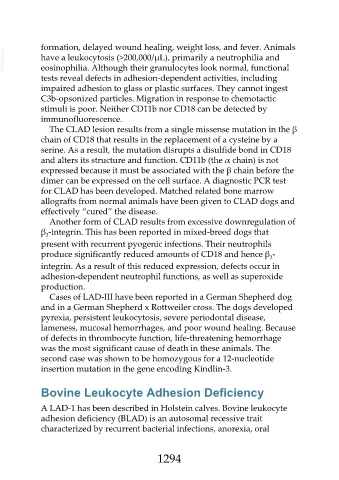Page 1294 - Veterinary Immunology, 10th Edition
P. 1294
formation, delayed wound healing, weight loss, and fever. Animals
VetBooks.ir have a leukocytosis (>200,000/µL), primarily a neutrophilia and
eosinophilia. Although their granulocytes look normal, functional
tests reveal defects in adhesion-dependent activities, including
impaired adhesion to glass or plastic surfaces. They cannot ingest
C3b-opsonized particles. Migration in response to chemotactic
stimuli is poor. Neither CD11b nor CD18 can be detected by
immunofluorescence.
The CLAD lesion results from a single missense mutation in the β
chain of CD18 that results in the replacement of a cysteine by a
serine. As a result, the mutation disrupts a disulfide bond in CD18
and alters its structure and function. CD11b (the α chain) is not
expressed because it must be associated with the β chain before the
dimer can be expressed on the cell surface. A diagnostic PCR test
for CLAD has been developed. Matched related bone marrow
allografts from normal animals have been given to CLAD dogs and
effectively “cured” the disease.
Another form of CLAD results from excessive downregulation of
β -integrin. This has been reported in mixed-breed dogs that
2
present with recurrent pyogenic infections. Their neutrophils
produce significantly reduced amounts of CD18 and hence β -
2
integrin. As a result of this reduced expression, defects occur in
adhesion-dependent neutrophil functions, as well as superoxide
production.
Cases of LAD-III have been reported in a German Shepherd dog
and in a German Shepherd x Rottweiler cross. The dogs developed
pyrexia, persistent leukocytosis, severe periodontal disease,
lameness, mucosal hemorrhages, and poor wound healing. Because
of defects in thrombocyte function, life-threatening hemorrhage
was the most significant cause of death in these animals. The
second case was shown to be homozygous for a 12-nucleotide
insertion mutation in the gene encoding Kindlin-3.
Bovine Leukocyte Adhesion Deficiency
A LAD-1 has been described in Holstein calves. Bovine leukocyte
adhesion deficiency (BLAD) is an autosomal recessive trait
characterized by recurrent bacterial infections, anorexia, oral
1294

